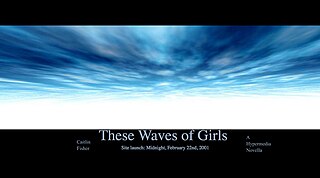
Hypertext is text displayed on a computer display or other electronic devices with references (hyperlinks) to other text that the reader can immediately access. Hypertext documents are interconnected by hyperlinks, which are typically activated by a mouse click, keypress set, or screen touch. Apart from text, the term "hypertext" is also sometimes used to describe tables, images, and other presentational content formats with integrated hyperlinks. Hypertext is one of the key underlying concepts of the World Wide Web, where Web pages are often written in the Hypertext Markup Language (HTML). As implemented on the Web, hypertext enables the easy-to-use publication of information over the Internet.

In computing, a hyperlink, or simply a link, is a digital reference to data that the user can follow or be guided to by clicking or tapping. A hyperlink points to a whole document or to a specific element within a document. Hypertext is text with hyperlinks. The text that is linked from is known as anchor text. A software system that is used for viewing and creating hypertext is a hypertext system, and to create a hyperlink is to hyperlink. A user following hyperlinks is said to navigate or browse the hypertext.
Project Xanadu was the first hypertext project, founded in 1960 by Ted Nelson. Administrators of Project Xanadu have declared it superior to the World Wide Web, with the mission statement: "Today's popular software simulates paper. The World Wide Web trivialises our original hypertext model with one-way ever-breaking links and no management of version or contents."
Hypertext fiction is a genre of electronic literature, characterized by the use of hypertext links that provide a new context for non-linearity in literature and reader interaction. The reader typically chooses links to move from one node of text to the next, and in this fashion arranges a story from a deeper pool of potential stories. Its spirit can also be seen in interactive fiction.

A dysfunctional family is a family in which conflict, misbehavior, and often child neglect or abuse on the part of individual parents occur continuously and regularly. Children that grow up in such families may think such a situation is normal. Dysfunctional families are primarily a result of two adults, one typically overtly abusive and the other codependent, and may also be affected by substance abuse or other forms of addiction, or sometimes by an untreated mental illness. Parents having grown up in a dysfunctional family may over-correct or emulate their own parents. In some cases, the dominant parent will abuse or neglect their children and the other parent will not object, misleading a child to assume blame.
Electronic literature or digital literature is a genre of literature where digital capabilities such as interactivity, multimodality or algorithmic text generation are used aesthetically. Works of electronic literature are usually intended to be read on digital devices, such as computers, tablets, and mobile phones. They cannot be easily printed, or cannot be printed at all, because elements crucial to the work cannot be carried over onto a printed version.

Jane Yellowlees Douglas is a pioneer author and scholar of hypertext fiction. She began writing about hypermedia in the late 1980s, very early in the development of the medium. Her 1993 fiction I Have Said Nothing, was one of the first published works of hypertext fiction.
Eastgate Systems is a publisher and software company headquartered in Watertown, Massachusetts, which publishes hypertext.
Adaptive hypermedia (AH) uses hypermedia which is adaptive according to a user model. In contrast to regular hypermedia, where all users are offered the same set of hyperlinks, adaptive hypermedia (AH) tailors what the user is offered based on a model of the user's goals, preferences and knowledge, thus providing links or content most appropriate to the current user.
Hypervideo, or hyperlinked video, is a displayed video stream that contains embedded, interactive anchors, allowing navigation between video and other hypermedia elements. Hypervideo is similar to hypertext, which allows a reader to click on a word in one document and retrieve information from another document, or another place in the same document. Hypervideo combines video with a non-linear information structure, allowing a user to make choices based on the content of the video and the user's interests.

Deena Larsen is an American new media and hypertext fiction author involved in the creative electronic writing community since the 1980s. Her work has been published in online journals such as the Iowa Review Web, Cauldron and Net, frAme, inFLECT, and Blue Moon Review. Since May 2007, the Deena Larsen Collection of early electronic literature has been housed at the Maryland Institute for Technology in the Humanities.

Hypertext is text displayed on a computer or other electronic device with references (hyperlinks) to other text that the reader can immediately access, usually by a mouse click or keypress sequence. Early conceptions of hypertext defined it as text that could be connected by a linking system to a range of other documents that were stored outside that text. In 1934 Belgian bibliographer, Paul Otlet, developed a blueprint for links that telescoped out from hypertext electrically to allow readers to access documents, books, photographs, and so on, stored anywhere in the world.
Penelope Trunk, is an American writer and entrepreneur. Trunk published works in the early 2000s under the pen name Adrienne Eisen and later under the name Penelope Trunk, a name she adopted in her public life.
"I Have Said Nothing" is an early work of hypertext fiction written by J. Yellowlees Douglas. In 1993 it was published by Eastgate Systems, Inc. in The Eastgate Quarterly Review of Hypertext , along with “Lust” by Mary-Kim Arnold. In 1997, Norton Anthology published an online version of the work, along with Michael Joyce's afternoon, a story as part of its print publication Norton Anthology of Postmodern American Fiction.

Figurski at Findhorn on Acid is a hypertext novel by Richard Holeton published on CD-ROM by Eastgate Systems in 2001 and republished on the open web by the Electronic Literature Lab, Washington State University, in 2021. Re-Imagined Radio presented a radio interpretation of this novel in 2022 in which Holeton made an appearance. It is a work of interactive fiction with various paths for readers to choose from, an early example of electronic literature, and one of 23 works included in the literary hypertext canon.

These Waves of Girls is a hypermedia novella by Caitlin Fisher that won the Electronic Literature Organization's Award for Fiction in 2001. The work is frequently taught in undergraduate literature courses and is referenced in the field of electronic literature as a significant example of early multimodal web-based hypertext fiction, placing Fisher "at the forefront of digital writing".
The Unknown is a web-based hypertext novel written by William Gillespie, Scott Rettberg and Dirk Stratton with Frank Marquardt. It won the 1999 Trace/Alt-X International Hypertext Contest. The name The Unknown was used to refer to both the work and its authors.
Carolyn Guertin is a Canadian artist, scholar, and author. Guertin is known for critical writing related to cyberfeminism, born-digital arts, participatory cultures, theoretical work in emergent media arts and literatures, global digital culture, information aesthetics, hacktivism, tactical media, and the social practices surrounding technology.
Caitlin Fisher is a Canadian media artist, poet, writer, and Professor of Cinema and Media Arts at York University in Toronto where she also directs the Immersive Storytelling Lab and the Augmented Reality Lab. Fisher is also a Co-founder of York’s Future Cinema Lab, former Fulbright and Canada Research Chair and an international award-winning digital storyteller. Creator of some of the world’s first AR poetry and long-from VR narratives. Fisher is also known for the 2001 hypermedia novel These Waves of Girls, and for her work creating content and software for augmented reality.







